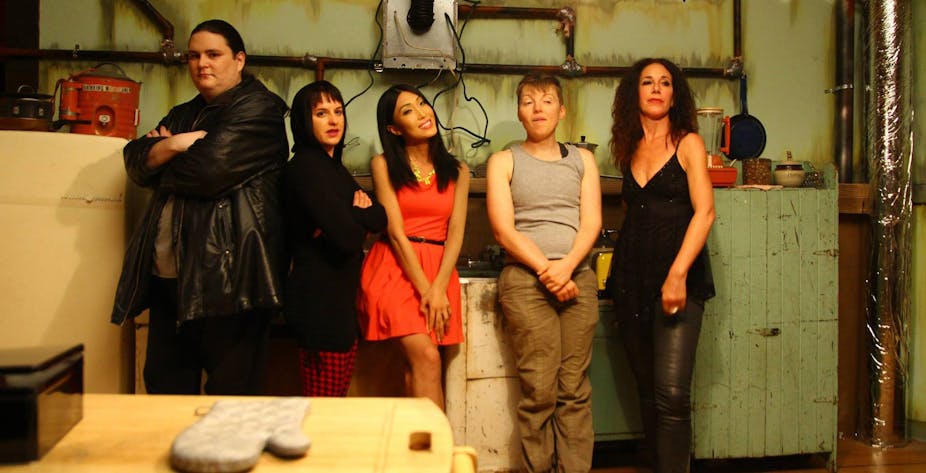The Canadian production company Trembling Void has just successfully crowdfunded a new television series called The Switch. The project is a comedy tracing the lives of an ensemble of trans characters. It explores the ups and downs of its misunderstood gender non-conforming community – with a lot of laughs along the way. What’s more, The Switch offers some powerful alternatives to mainstream media’s representation of trans experience.
Trans women on television
The Switch will be the first transgender comedy series and actress Julie Vu the first trans woman in a lead role on television. Laverne Cox is the first openly trans woman to be nominated for an Emmy for her work on Orange is the New Black. Candis Cayne was the first trans woman to play a recurring trans role network television in the drama Dirty Sexy Money. But Julie Vu is the first lead. The show is an opportunity to expand the mainstream media’s limited, and frequently misleading depiction of what it means to be trans and female identified.
Writer Amy Fox admits one of her motivations for creating the show was a struggle to make sense of her own identity. The narrow cis-gendered views of trans women in the media simply did not match her own experiences.
And no wonder.
The 2013 review of transgender images on television undertaken by US LGBT lobby group GLAAD, showed there’s a lot of room for improvement. The review found that between 2002 and 2012 only 12% of transgender characters to appear on television were positive.
As GLAAD president Herndon Graddick wrote at the time:
Media has a history of telling the world a story that transgender people are always victims or villains, instead of true depictions that show the transgender community as citizens worthy of equality and respect.
And as transgender activist Julia Serano points out in her book Whipping Girl, it is the representation of trans women that is most visible and most problematic.
This is also evident in the tone of reportage the media have adopted when they take on trans stories. “Victim” and “villain” narratives focus on how successfully (or unsuccessfully) trans women “arrive” at their target gender – whether or not a trans woman is actually seeking to arrive at a gender.
The two types of trans women
This is played out in the way that trans women are reported as being either transgressive or transcendent.
Often journalists describe trans women – or people they understand to be trans women – in terms of masculinity or confusion about physical gender expression. That trans woman is then presented as transgressive.
Reports of such transgressive trans women are generally hostile, with journalists tapping into prejudice and moral panic. There are, unfortunately, many recent examples of this tendency.
UK school teacher Lucy Meadows committed suicide after hostile media attention raised questions over her suitability as a teacher. Fallon Fox, a mixed martial arts competitor, who came under intense attack for supposed advantages over cis-gendered women. There’s no end to bathroom panic reportage – stories about visibly recognisable trans women and teenagers using female bathrooms. And then there’s the murder of trans teenager Larry King, which was reported in a way that suggested that King’s gender identity was responsible for his death.
Beauty conquers all
Conversely, if the media can describe a trans woman in terms of beauty and femininity — then that trans woman is seen as transcendent. Transcendent narratives become about overcoming a trans woman’s invisible (but still present) birth gender.
This is most evident in the media’s fascination with trans activists and celebrities like Carmen Carrera, Janet Mock, Laverne Cox, Lea T, and Andrej Pejic. At the centre of this fascination is how little these women resemble the media’s expectations of their birth gender.
Recently, CNN journalist Piers Morgan drew heavy criticism and international attention when in his interview with author and activist Janet Mock he repeatedly focused on her assigned birth gender and how little she resembled it.
Similarly, Carmen Carrera and Laverne Cox faced repeated questions about surgery and genitals when they were interviewed by interviewer Katie Couric. Cox articulately pointed out that the media’s focus on transition and surgery had nothing to do with trans people’s lived experiences.
The focus on beauty and femininity is hardly restricted to celebrities though. In 2012 the New York Times drew criticism for the reportage of the death of transgender performer Lorena Escalera in a fire. Journalists described Escalera as both “curvaceous” and “gorgeous” while unnecessarily identifying her as a man and referring to her supposed promiscuity.
Where are the rest of the stories about trans women?
Those few who are able to fit the stereotypes about trans women are lauded. In some cases, and recently, more frequently, they find their way into the mainstream media. When trans woman iiGethi shared images of her male to female transition on YouTube, the clip went viral.
These stories of acceptance, are, however, the exceptions, and many trans women face ridicule and misunderstanding. In a community noted for having an extraordinarily high suicide rate, this is a pressing concern.
Which is why projects like The Switch, that broaden our understanding of what it means to be trans, are so important. It’s not just so that trans people can be seen as citizens worthy of respect, but because trans people need their own stories.

